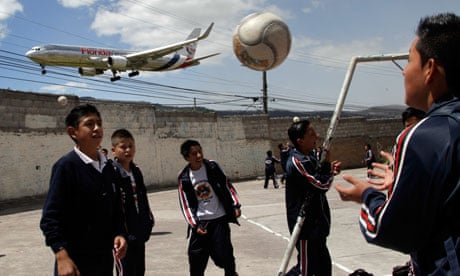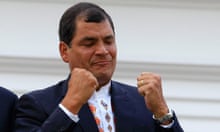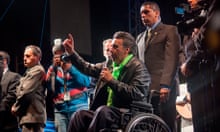One of the world's most spectacular and stomach-churning aircraft descents will be consigned to history next week when Quito closes an airport wedged between volcanoes and tower blocks high in the windswept Andes.
The Mariscal Sucre international airport, which serves the Ecuadorean capital, has long been notorious for difficult flight paths and treacherous weather that have together contributed to nine fatal accidents in the past 30 years.
To land, pilots have to bank around heavily populated mountain slopes and then dip down onto a 2 mile (3km) airstrip that is boxed inside the city centre. To clear the ridges after take-off, they have to pull up sharply which strains engines that cannot run at full capacity because of the thin air at this 2,800 metres (9,100ft) altitude.
Since it opened in 1960, such challenges have become familiar to airline crews in Latin America that serve this busy airport, which has an average of 220 flights a day and about 10m passenger movements a year.
But as the city has grown to surround it, neighbouring residents have to endure the roar of jets from 5.30am to 2am, as well as the risk of accidents.
Aircraft have clipped or crashed into nearby buildings four times since 1984, killing 135 people. Other disasters have been caused by navigation errors that led planes to plunge into the sides of volcanoes.
However, the closure has as much to do with business as safety. Having grown to maximum capacity, the operators will expand by moving to a new airport at Tababela, 12 miles outside the city centre. But this too has been bedeviled by controversy.
It has been built to handle 290 flights a day despite road links being poor; with congestion, the journey from the city centre can take 90 minutes.
It is situated in cropland and will have a runway that is more than 1,000 metres longer than the old airport, which should reduce the problem of over-runs which have been a major cause of accidents. It is also 400 metres lower, which will slightly improve engine performance.
City officials say this will allow the new airport to handle transcontinental flights, which is not currently possible. "These two factors will make aeronautic operations easier and enable Quito to serve long-range flights," said Freddy Equez Rivera, general manager of municipal aviation services.
He said an easier approach would make for safer flights, but this has been disputed by many pilots who doubt the new facility will bring significant safety benefits.
"Pilots don't approve. The microclimate in the valley where the airport is located is very complicated and there is low visibility for 80% of the year," said Stephano Rota, a corporate pilot. "The current airport is probably among the five most difficult airports to fly into in Latin America. The new one could be even more challenging."
The shift is part of a global trend to move major airports out of city centres. Among the famous white-knuckle landings that no longer exist is that of Kai Tak, in Hong Kong. But thrill-seekers and flight simulators who want to experience difficult landings can still fly into airports at Cuzco, Innsbruck, Kathmandu, St Barts and elsewhere.








Comments (…)
Sign in or create your Guardian account to join the discussion